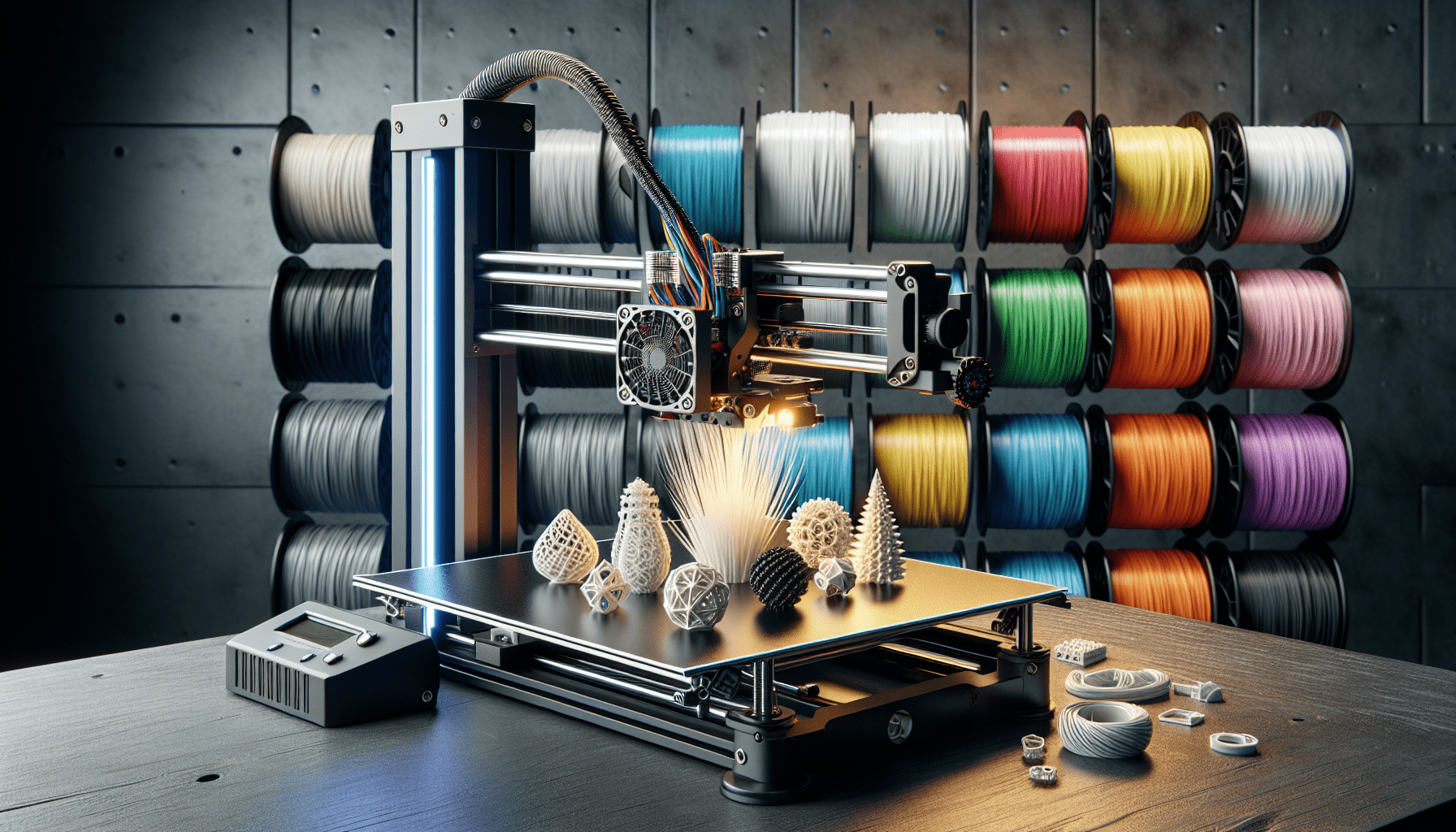Sovol SV08 Core-XY 3D Printer Voron 2.4 Open Source, 700mm/s High Speed 3D Printers with 300℃ Clog-Free Hotend & Camera, Auto Leveling with 4 Independent Z Motors, Large Print Size 13.8x13.8x13.6in
$699.99 (as of June 18, 2025 23:32 GMT +00:00 - More infoProduct prices and availability are accurate as of the date/time indicated and are subject to change. Any price and availability information displayed on [relevant Amazon Site(s), as applicable] at the time of purchase will apply to the purchase of this product.)In a rapidly evolving manufacturing landscape, the potential of 3d printing for mass-producing up to 100,000 parts presents a significant shift in how you can approach production. This article will illuminate the economic advantages, scalability, and design flexibility integral to 3D printing. By leveraging the capabilities of Slant 3D’s print farms, you can greatly enhance your product development lifecycle, allowing for faster iterations and reduced upfront capital expenditure.
Moreover, 3D printing introduces a sustainable manufacturing alternative, minimizing carbon emissions by localizing production and utilizing digital warehouses. In addition to environmental benefits, the adaptability of 3D printing ensures that you can meet dynamic market demands by real-time updates and modifications to your products. This reduces the rigid constraints of traditional manufacturing, offering a more agile and cost-efficient solution.
Cost-Effectiveness of 3D Printing for High Volume Production

Comparison of Initial Setup Costs with Traditional Manufacturing
When you compare the initial setup costs of 3D printing to traditional manufacturing methods such as injection molding, you will find a significant difference. Traditional manufacturing requires expensive tooling, such as molds, which can cost tens of thousands of dollars and can take weeks to produce. In contrast, 3D printing requires no such tooling. The initial setup cost for 3D printing is considerably lower, primarily consisting of the cost of the 3D printer and the corresponding software. This cost-effectiveness makes 3D printing an attractive option, especially for companies looking to produce fewer than 100,000 units.
Reduced Material Costs and Waste
Another substantial advantage of 3D printing is the reduced material costs and significantly minimized waste. Traditional manufacturing methods often involve cutting away excess material, resulting in waste. However, 3D printing is an additive process, meaning material is only used where necessary. This reduction in waste not only lowers material costs but also contributes to more sustainable manufacturing practices. As a result, you can achieve high-volume production with lower material expenses compared to traditional methods.
Long-term Financial Benefits
In the long term, 3D printing offers financial benefits by eliminating the need for multiple production runs to test and iterate on designs. Since changes to a design do not require new tooling or significant re-setup costs, you can make modifications quickly and at a lower cost. This flexibility reduces financial risk and makes it easier to adapt to changing market demands. Over time, the operational savings obtained from less retooling and quicker design iterations can significantly outweigh the initial investment in 3D printing equipment.
Scalability of Mass Production with 3D Printing
How Print Farms Operate on a Large Scale
Print farms operate by using a large number of 3D printers working simultaneously to produce parts. These farms can consist of hundreds or even thousands of printers, all managed through centralized software. This allows for continuous production 24/7, ensuring that high-volume orders can be fulfilled efficiently. The decentralized nature of these farms means that even if one printer fails, the impact on overall production is minimized.
Examples of Scalability from Different Industries
Scalability in 3D printing has been successfully demonstrated across various industries. For instance, the automotive industry uses 3D printing for both prototyping and producing complex components that would be too expensive or impractical to manufacture using traditional methods. Similarly, the healthcare industry leverages 3D printing to produce customized implants and prosthetics on a large scale. Consumer goods manufacturers also use 3D printing to quickly produce and test new product designs before committing to larger-scale production.
Challenges and Solutions in Scaling Up Production
Scaling up 3D printing for mass production comes with its own set of challenges, such as ensuring consistency and quality across all parts produced. Solutions to these challenges include implementing stringent quality control measures and using advanced monitoring systems to track the performance of individual printers. Additionally, using standardized materials and processes can help maintain quality across large batches. Companies can also invest in training for operators to troubleshoot and maintain the printers effectively.
Flexibility and Customization in 3D Printing
Advantages of On-Demand Manufacturing
On-demand manufacturing with 3D printing allows you to produce parts as needed, without the need for large inventories. This reduces storage costs and minimizes the risk of obsolescence. Additionally, it allows for greater flexibility in responding to changes in demand, as you can quickly ramp up or scale down production based on current needs. This flexibility is particularly beneficial for businesses with fluctuating demand or those introducing new products to the market.
Customizing Products for Market Testing
One of the most significant advantages of 3D printing is the ability to customize products easily. This capability is invaluable for market testing, as it allows you to produce small batches of customized items to gauge consumer interest. You can quickly make adjustments based on feedback without incurring substantial costs. This iterative approach to product development can lead to better products that are more aligned with market needs.
Find 3D Printing Accessories Here
Case Studies of Successful Customizable Product Lines
Several companies have successfully leveraged 3D printing for customizable product lines. For instance, shoe manufacturers have used 3D printing to create custom insoles tailored to the unique shape of individual customers’ feet. Similarly, eyewear companies have produced custom frames based on facial scans, providing a perfect fit for each customer. These case studies demonstrate the potential of 3D printing to offer highly personalized products that meet specific consumer needs.
Sustainability and Eco-Friendly Production
Reduction of Carbon Footprint through Local Production
3D printing significantly contributes to reducing the carbon footprint associated with manufacturing. By enabling local production, it eliminates the need for long-distance shipping and reduces associated emissions. Local production also allows for a more responsive supply chain, reducing the energy and resources required to manage inventories and fulfill orders.
Minimizing Waste in the Production Process
As previously mentioned, the additive nature of 3D printing minimizes waste by using only the necessary material to create an object. This contrasts with subtractive manufacturing methods, which often result in significant material waste. Moreover, any leftover materials from 3D printing can often be recycled and reused, further enhancing the sustainability of the process.
Sustainable Materials Used in 3D Printing
Many sustainable materials are now available for use in 3D printing. These include biodegradable plastics, recycled materials, and even renewable resources like algae-based filaments. By choosing sustainable materials, manufacturers can further reduce the environmental impact of their production processes. This shift towards eco-friendly materials aligns with growing consumer demand for sustainable products and practices.
Digital Warehousing and Inventory Management
The Concept of Digital Warehouses
Digital warehouses revolutionize traditional inventory management by storing parts digitally rather than physically. Instead of maintaining a large stock of physical items, a digital warehouse maintains design files that can be printed on demand. This approach reduces storage costs and the risk of obsolescence while ensuring that parts are always available when needed.
Benefits of Storing Parts Digitally
Storing parts digitally offers numerous benefits, including reduced physical storage space and lower inventory management costs. Digital storage also allows for rapid reproduction of parts, minimizing downtime in case of a component failure. Additionally, it enables easier updates and modifications to parts, as changes can be quickly implemented without the need for new physical inventory.
Impact on Inventory Management and Supply Chain
Digital warehousing and on-demand printing transform how you manage inventory and supply chains. With parts stored digitally, you can reduce lead times and respond more quickly to market changes. This flexibility improves supply chain resilience and decreases the risk of stockouts or overproduction. Ultimately, digital warehousing supports a more agile and efficient manufacturing process.
Design Considerations for 3D Printing
Importance of Designing Specifically for 3D Printing
Designing specifically for 3D printing involves understanding the capabilities and limitations of the technology. Unlike traditional manufacturing methods, 3D printing allows for complex geometries and intricate details that would be impossible or too costly to achieve otherwise. However, it requires a different approach to design, considering factors such as layer height, print orientation, and support structures.

Common Design Pitfalls and How to Avoid Them
Common pitfalls in 3D printing design include overhangs that require excessive support, thin walls that are prone to breaking, and complex geometries that increase print time and cost. To avoid these issues, you should follow best practices such as optimizing wall thickness, minimizing the need for supports, and designing parts for ease of printing. Additionally, using design validation software can help identify and address potential problems before printing.
Tools and Software to Aid in 3D Printing Design
Several tools and software are available to aid in designing for 3D printing. CAD (Computer-Aided Design) software such as Autodesk Fusion 360 and SolidWorks are popular choices for creating detailed 3D models. Additionally, slicer software like Cura and Simplify3D is essential for converting CAD models into printable files. These tools offer features specifically designed for 3D printing, making it easier to create high-quality, optimized designs.
Iterative Development and Rapid Prototyping
The Role of Rapid Prototyping in Product Development
Rapid prototyping plays a crucial role in product development by allowing you to quickly produce and test physical models of your designs. This approach enables you to identify and address issues early in the development process, reducing the time and cost associated with bringing a new product to market. With 3D printing, you can create multiple iterations of a prototype in a matter of days, accelerating the development cycle.
Benefits of Quick Iterations and Feedback Loops
The ability to quickly produce and test multiple iterations of a design offers significant advantages. You can gather feedback from stakeholders and end-users earlier in the development process, making it easier to refine and improve the product. This iterative approach leads to better-designed products that meet user needs more effectively. Additionally, it reduces the risk of costly design changes later in the process.
Examples of Products Developed through Iterative Design
Many successful products have been developed through iterative design using 3D printing. For example, consumer electronics companies use rapid prototyping to test the ergonomics and functionality of new devices. Similarly, the automotive industry uses 3D printing to rapidly iterate on design features, such as aerodynamic components. These examples demonstrate how quick iterations and feedback loops can lead to superior products and more efficient development processes.
Case Studies and Industry Applications
Success Stories from Different Sectors
Various industries have successfully adopted 3D printing for mass production. In the medical field, companies like Align Technology use 3D printing to produce custom dental aligners, reaching millions of patients worldwide. The aerospace industry employs 3D printing for producing lightweight components, leading to significant weight savings and improved fuel efficiency. The fashion industry also benefits, with designers creating unique, customizable pieces that would be challenging to produce traditionally.
Lessons Learned from Large-Scale 3D Printing Projects
Large-scale 3D printing projects offer valuable lessons in terms of achieving consistency, managing costs, and ensuring quality. One key lesson is the importance of thorough planning and testing before scaling up production. Companies have found that investing in high-quality printers and materials pays off in the form of fewer failed prints and better overall quality. Another lesson is the critical role of maintenance and monitoring in keeping large print farms operational and productive.
Future Trends and Potential Applications
Looking ahead, the future of 3D printing in mass production is promising, with potential applications across numerous sectors. Advancements in printer technology and materials will continue to expand the range of products that can be efficiently manufactured using 3D printing. Future trends include increased use of multi-material printing, improved speed and precision, and the integration of AI and machine learning to optimize the printing process. These developments will further solidify 3D printing as a viable option for large-scale production.
Overcoming Challenges in Mass Production with 3D Printing
Technical Challenges and Solutions
Mass production with 3D printing presents technical challenges such as printer reliability, material consistency, and print speed. Solutions to these challenges include regular maintenance schedules, high-quality materials, and investment in advanced printers capable of faster production speeds. Additionally, software improvements, such as real-time monitoring and predictive maintenance, can help identify and address issues before they impact production.
Quality Control and Consistency
Ensuring quality control and consistency in mass production is crucial. Implementing standardized procedures and rigorous testing protocols can help maintain high quality across all printed parts. Automated inspection systems can be used to check for defects and ensure that each part meets the required specifications. By focusing on quality control, you can achieve consistency, which is essential for mass production success.
Economic Considerations and Risks
Economic considerations and risks include the initial investment in 3D printing technology, ongoing maintenance costs, and potential market fluctuations. However, when weighed against the cost savings from reduced waste, lower material costs, and the ability to quickly adapt to market changes, the long-term benefits often outweigh the risks. To mitigate economic risks, companies should conduct thorough cost-benefit analyses and develop robust business strategies that leverage the strengths of 3D printing.
Conclusion
Summary of Key Points
This article has explored the various aspects of using 3D printing for high-volume production, highlighting its cost-effectiveness, scalability, flexibility, and sustainability. The key points demonstrate that 3D printing offers significant advantages in reducing initial setup costs, minimizing waste, enabling on-demand manufacturing, supporting iterative development, and promoting sustainable practices.
The Transformative Potential of Mass-Producing with 3D Printing
The transformative potential of 3D printing in mass production is evident in its ability to produce high-quality, customized products at a lower cost and with greater speed than traditional manufacturing methods. As technology continues to advance, the capabilities of 3D printing will only expand, making it an increasingly viable option for a wide range of industries.
Final Thoughts and Recommendations for Manufacturers
For manufacturers considering mass production, 3D printing offers a compelling alternative to traditional methods. By investing in 3D printing technology and focusing on the principles of design for additive manufacturing, companies can achieve greater flexibility, cost savings, and sustainability. As you look to the future, embracing 3D printing could be the key to staying competitive in a rapidly changing market landscape.
This comprehensive approach highlights the multifaceted benefits and considerations of adopting 3D printing for mass production, providing you with the insights needed to make informed decisions in leveraging this innovative technology.
Maintain Your 3D Printer with these Tools








